Bornholm is often described as the jewel of the Baltic. So it is – a large island right in the middle of the western Baltic, blessed with the most sun and least rain in Denmark. It is often alluded to as Mediterranean-like and has fig trees growing, but it is still cold to us and, as this is written on 9th May, we are sitting out a rainy gale day!
Bornholm has been held by several nation states, notably Sweden, which it is geographically closest to, but the Bornholmers are an independent lot (as islanders usually are) and overthrew the Swedes and aligned themselves with Denmark. Their language is a dialect of Danish but quite hard for main-landers to understand and, unlike Danish, it retains three grammatical genders, as does Islandic.
Denmark is largely flat (although not by Dutch standards). Bornholm, however, is of granite, relatively high with gently rolling hills of arable fields and woodlands, now crossed by many cycle tracks. We found the woods abundant in wild garlic, which we have been enjoying as supper. In the south there are lots of sandy beaches but the north coast has rocky cliffs – a visitor attraction.
Gudhjem
As with islands in general, the light has a special brilliance and it has attracted many artists over the years, giving rise to the Bornholm School of impressionists and modernists. Cultural life is centred on Gudhjem. This was a fishing village once having thirty herring smokeries. Now is a centre for visitors and artists, as well as the departure point for Christiansø.

In the harbour 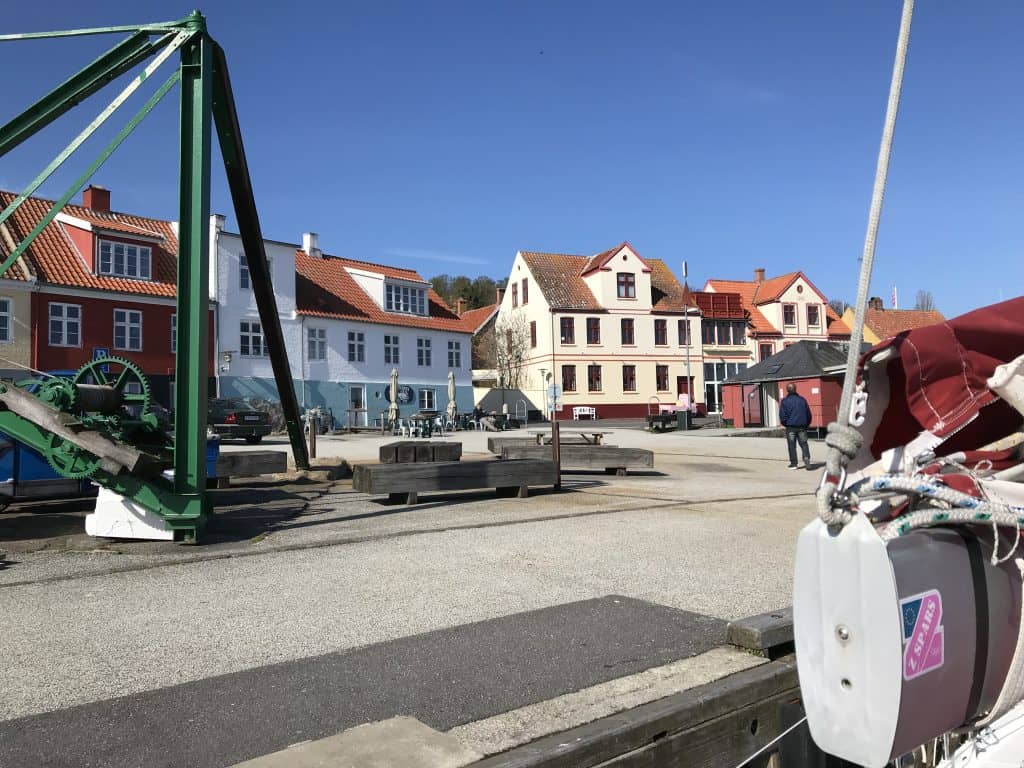
The dock with the bar 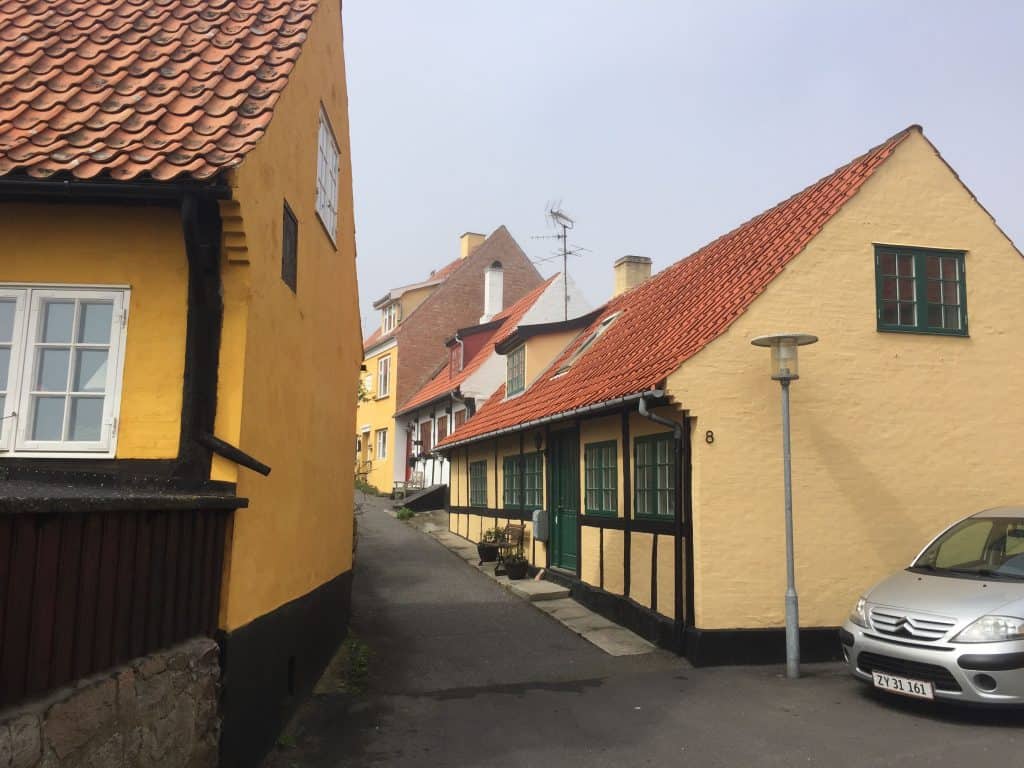
Gudhjem street 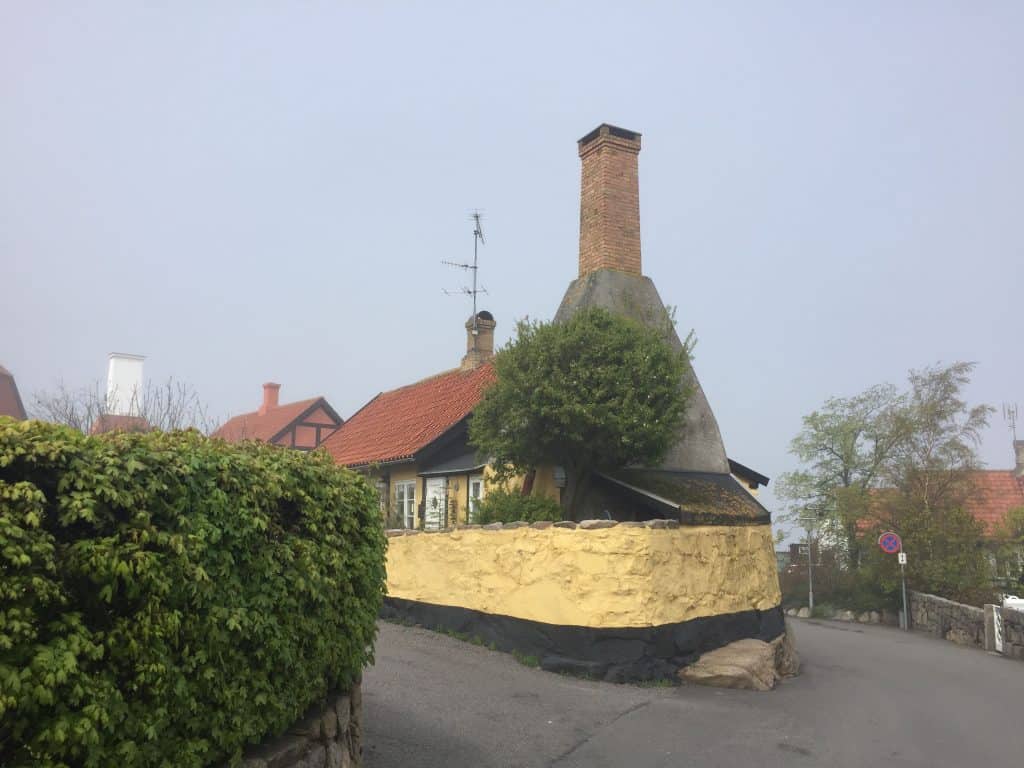
Cottage with smokery
The artist Oluf Høst (1884-1966) lived and worked in Gudhjem and we visited his lovely home, studio and garden, which are now a museum.
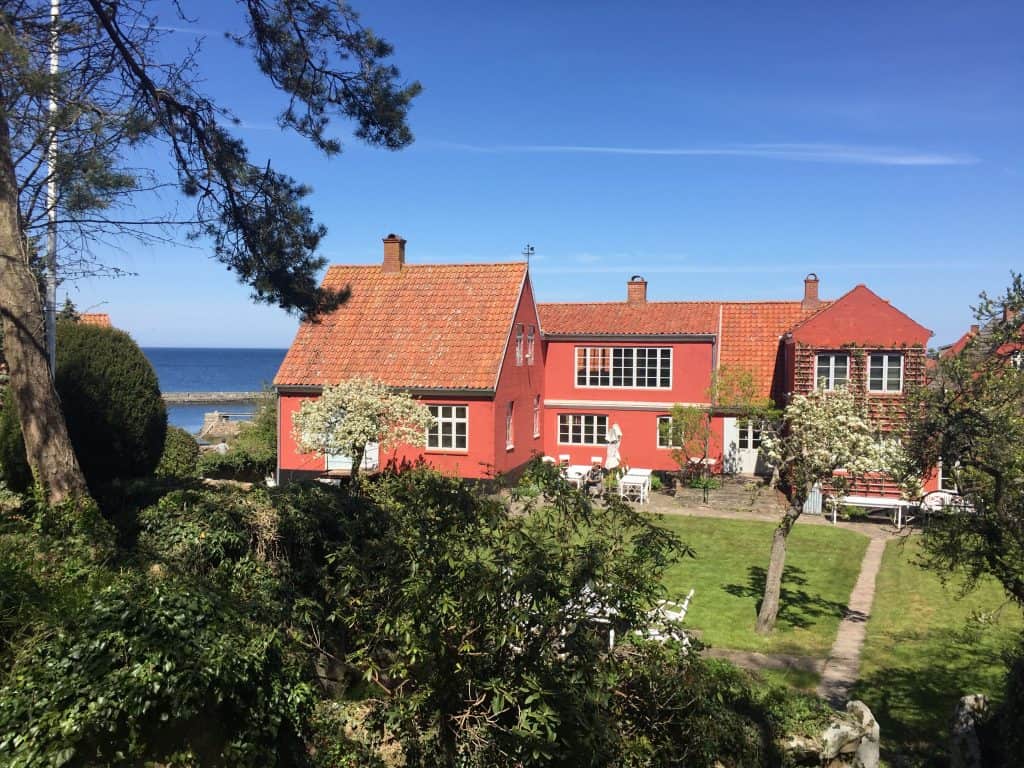
Oluf Høst’s house & studio from garden 
Dying of a winter’s day (1943) 
Sunset by the sea
We cycled and walked along the cliff path to the Bornholm Art Museum. This is a very fine modern building on open land overlooking the cliffs that were the inspiration for so many of the painters whose work is exhibited there.
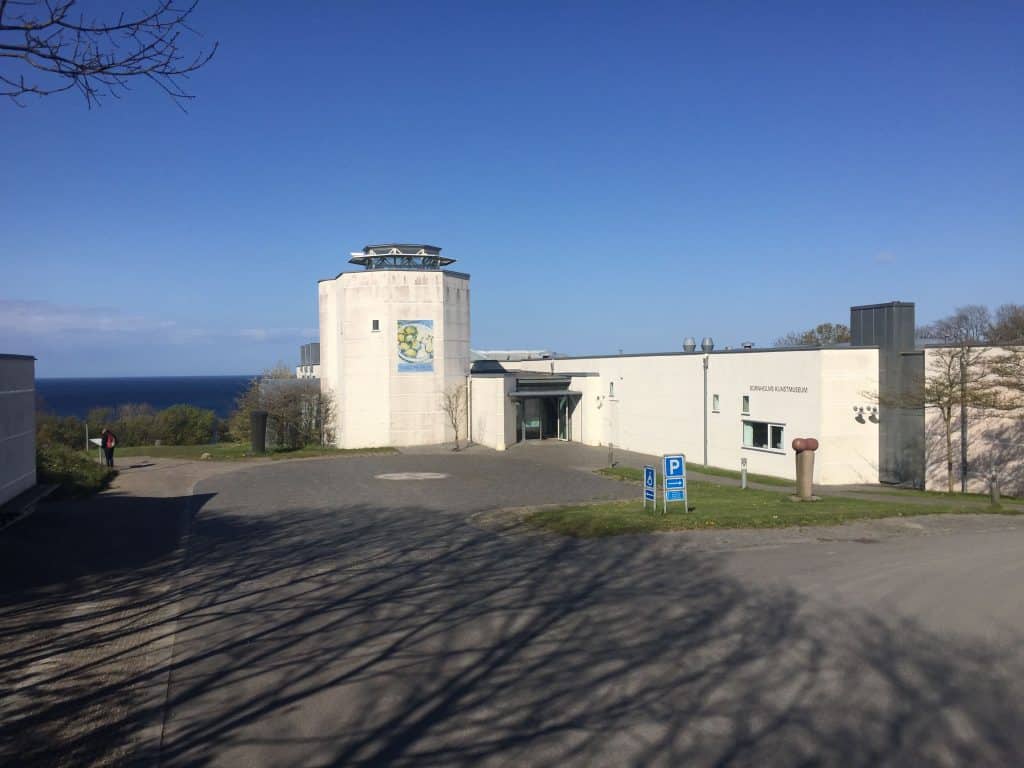
The Bornholm Art Museum 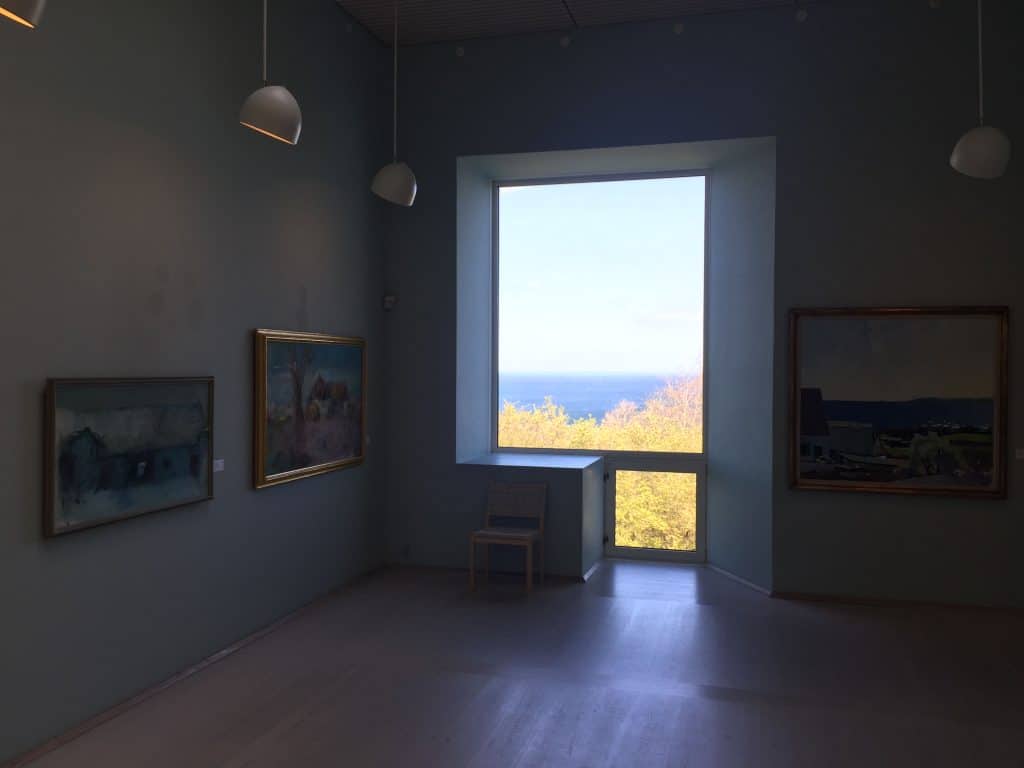
with views out… 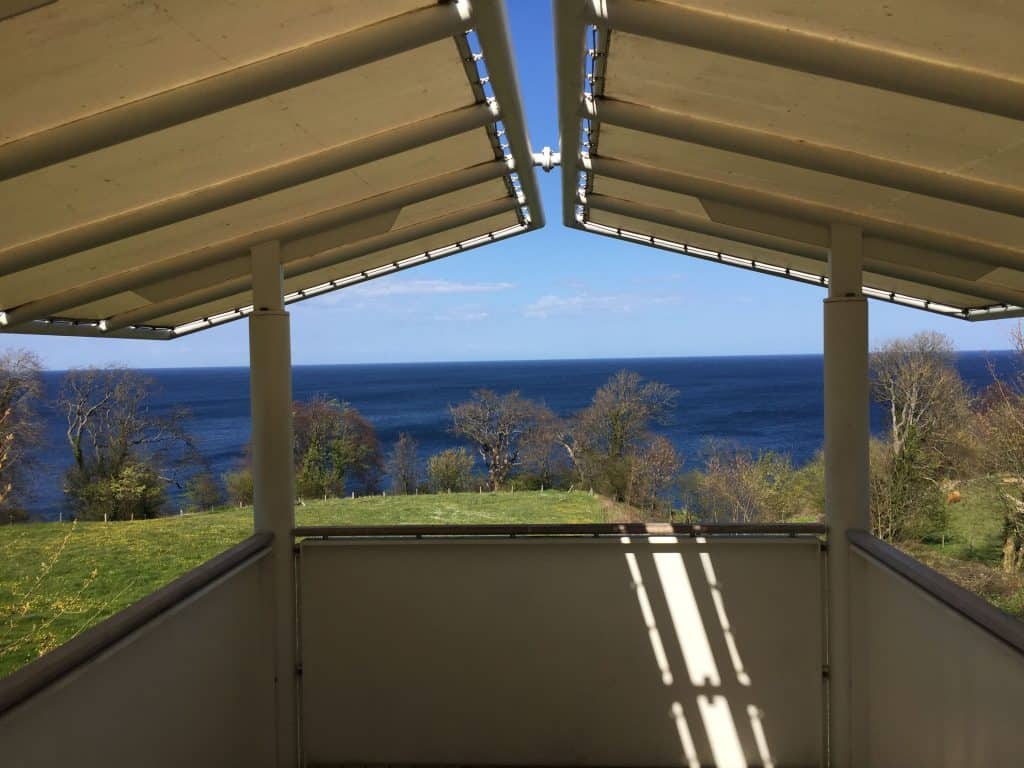
over the coast… 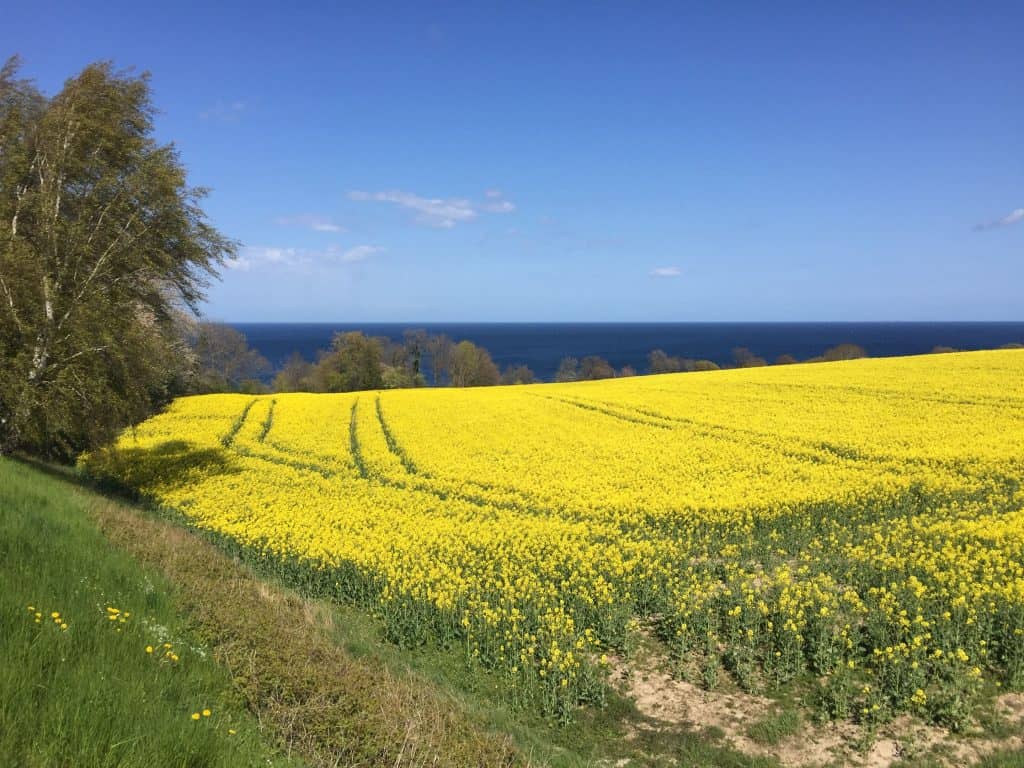
like this 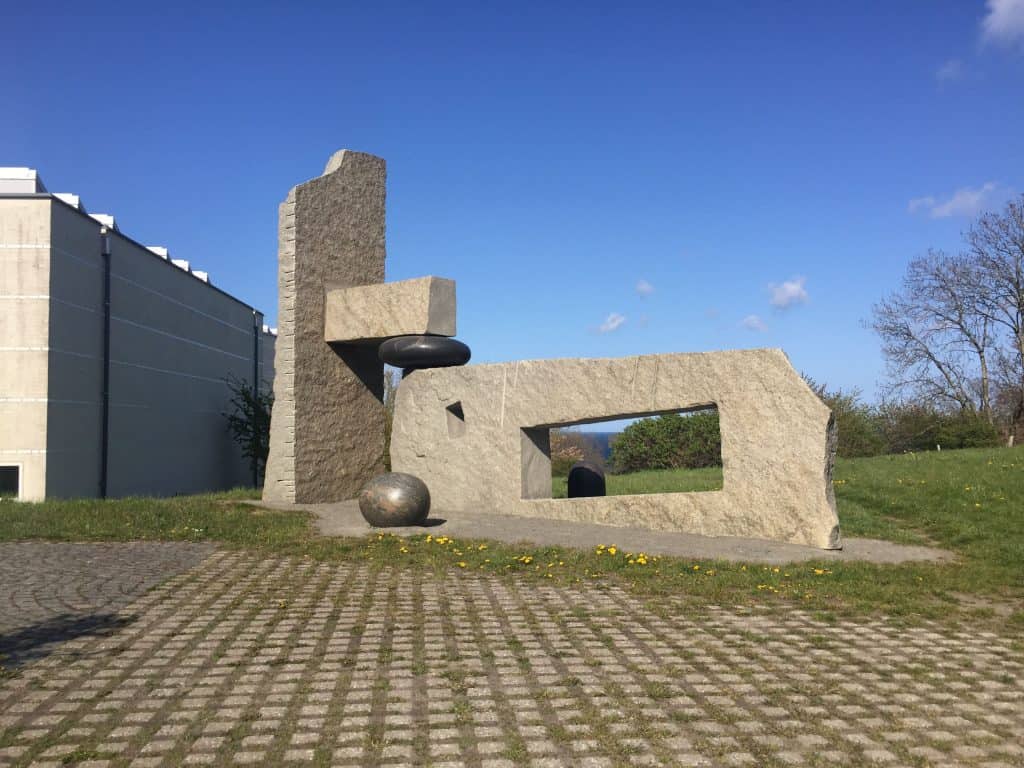
Sculpture at the museum
Bornholm is noted for its four round churches, which, as well as being places of worship, were once defendable refuges and stores. We cycled to Østerlars church (ca. 1150), which is quite amazing. The outer walls are over two metres thick and include narrow stairways to the upper stories. Perhaps most unexpected, as well as the round outside walls, there is a central inner core which forms a baptistry in the church at ground level and store room above. The second floor would once have been open to the sky and a defensive position but now has a wooden roof over it. Click on this gallery to view details.
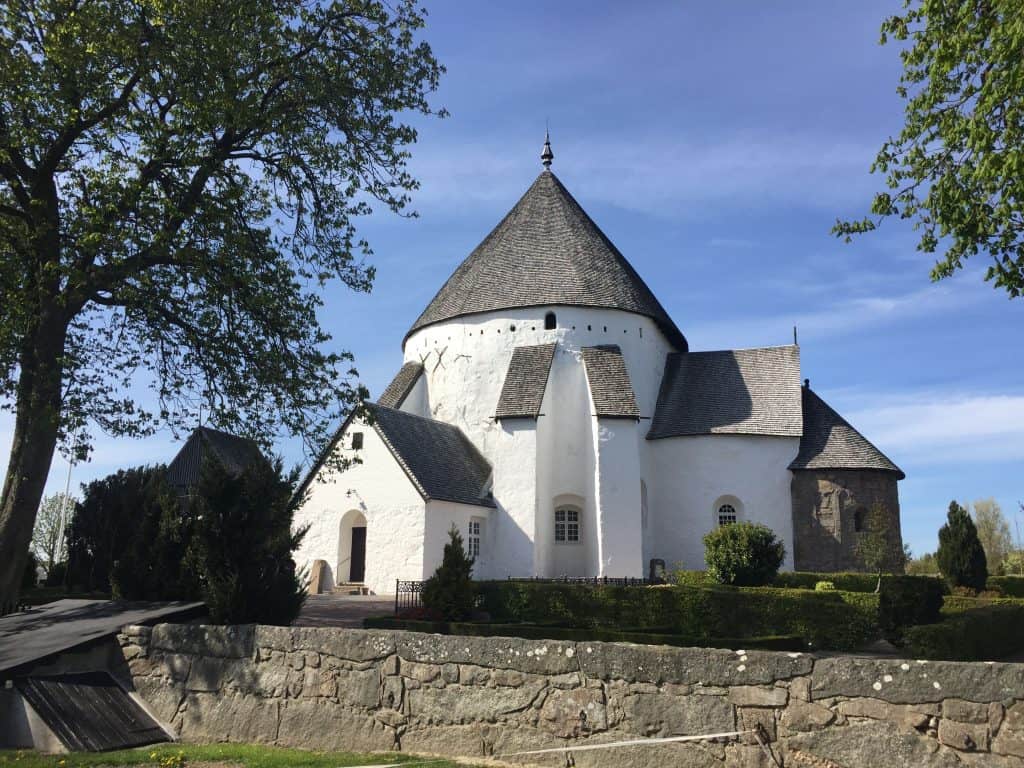
Østerlars church 
The central core with paintings… 
… forms the baptistry 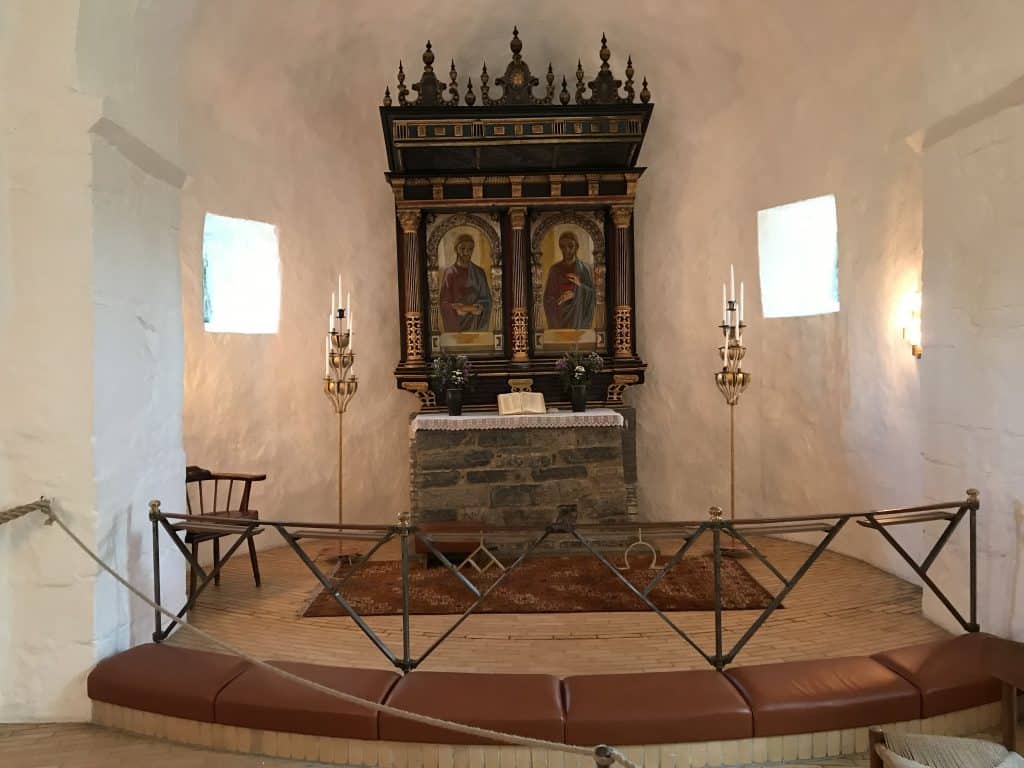
The alter

Each morning at 10:00, the ferry/excursion ship Ertholmen departs from Gudhjem for Christiansø. A local group of people gather daily on a nearby jetty to serenade those departing with Danish songs. We were invited by Jens the violinist to join them. Afterwards we repaired to the bar on the harbour front for coffee/tea/pastis. The songs are taken from a kind of hymn book familiar to Danish school children and were much appreciated by the departing passengers.
In acknowledgement of our upcoming passage through the Limfjord, they chose song 376.
Words of song 376 very roughly translated…
- The wind blows fresh over the waters of the Limfjord, shaking them up to awake the flight, chasing them between the embracing beaches, filling up with tones each a bay. And the summer sings behind his yacht on a cruise from the North Sea to the Kattegat.
- The garden stands high above the waters of the Limfjord, widening and healthy and twisted cove! Sallingland, Thyland and other countries greet each other with each other with gull warfare.
- And the farmer walks on his farm with his gaze rejuvenated by air and fjord. The light flashes over the waters of the Limfjord, sparks and laughs in a fighting game. The waves throw with fiery fires the white fire of the Viking dreams. And the youth feel the power of the fjord, far beyond the world stretched.
- Longing is salted in the waters of the Limfjord. Here I got the thrill of speed on cheek, here with cool splashes against my forehead was devoted to turmoil my sailors mind Yes, Limfjord, I love your blue mood in the gale from Hals and to Harbour.
We learnt that the bar imports its supply of wine direct from the south of France. This year’s order for 8000 bottles has just left France on board a traditional schooner with no engine. When the wind dictates, the schooner will come alongside in the harbour and the wine transferred the few metres into the store. At least one may enjoy the wine without concern for the environmental impact of it getting here.
On Friday evening we spent an excellent evening crammed into the very full bar with drinks, food and live music. There were lively discussions on many things and, inevitably, Brexit. We will be sad to leave.
Svaneke
At last the weather has turned kindly and, with a gentle westerly, we had an easy spinnaker run 9nm to Svaneke on the north eastern corner of Bornholm.
Svaneke is another former fishing port. Now it has become a centre for crafts people and has many shops selling ornaments, jewellery, ceramics and especially glass objects. Some premises have glass blowers working in the studio. It also has several craft breweries.
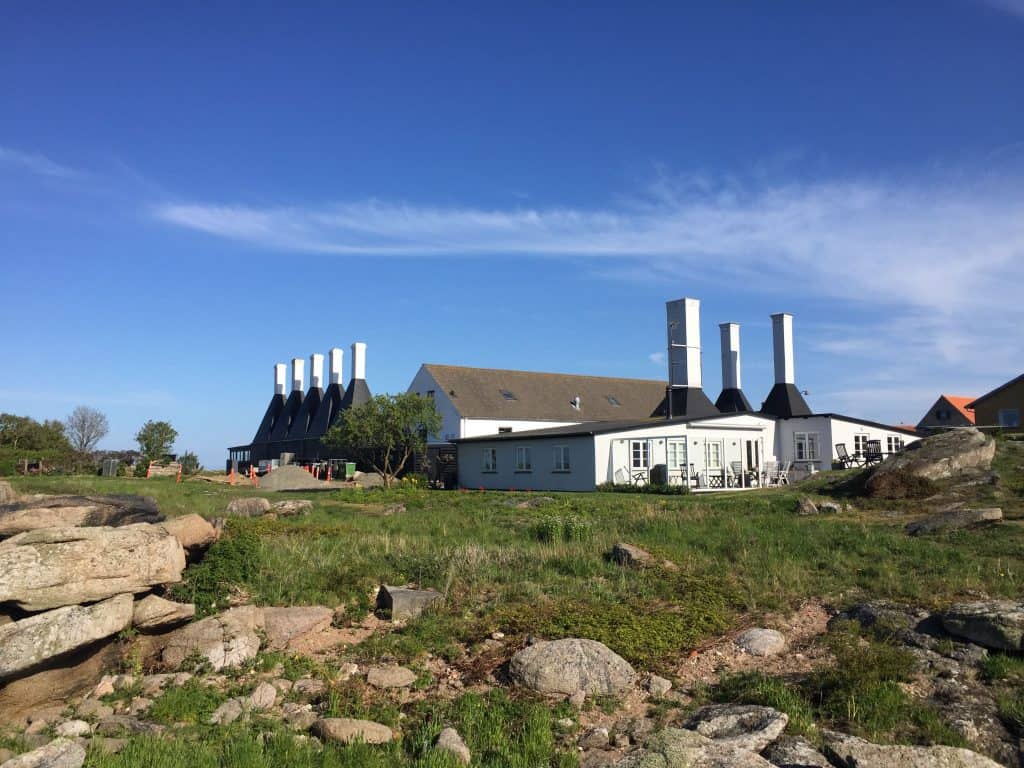
Coaches arrive each day bringing in tourists who visit the shops and then the smokeries to eat a herring. Smoking herrings is big business around here and Bornholm supplies the whole of Denmark.
These days the herrings are mostly brought in from the North Sea, as the smaller Baltic herring is subject to fishing quotas and polluted with dioxin etc.
Swaneke was rated in 2013 by Danes as its best preserved market town.

Svaneke from off shore 
Antipole in Svaneke harbour 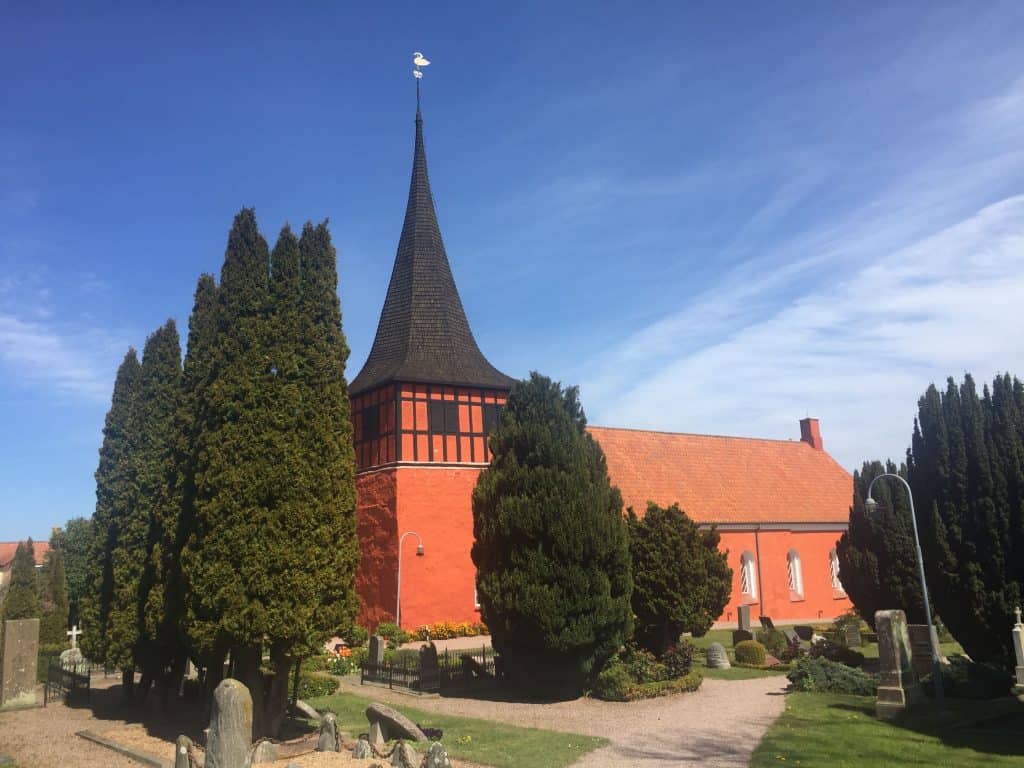
Svaneke church 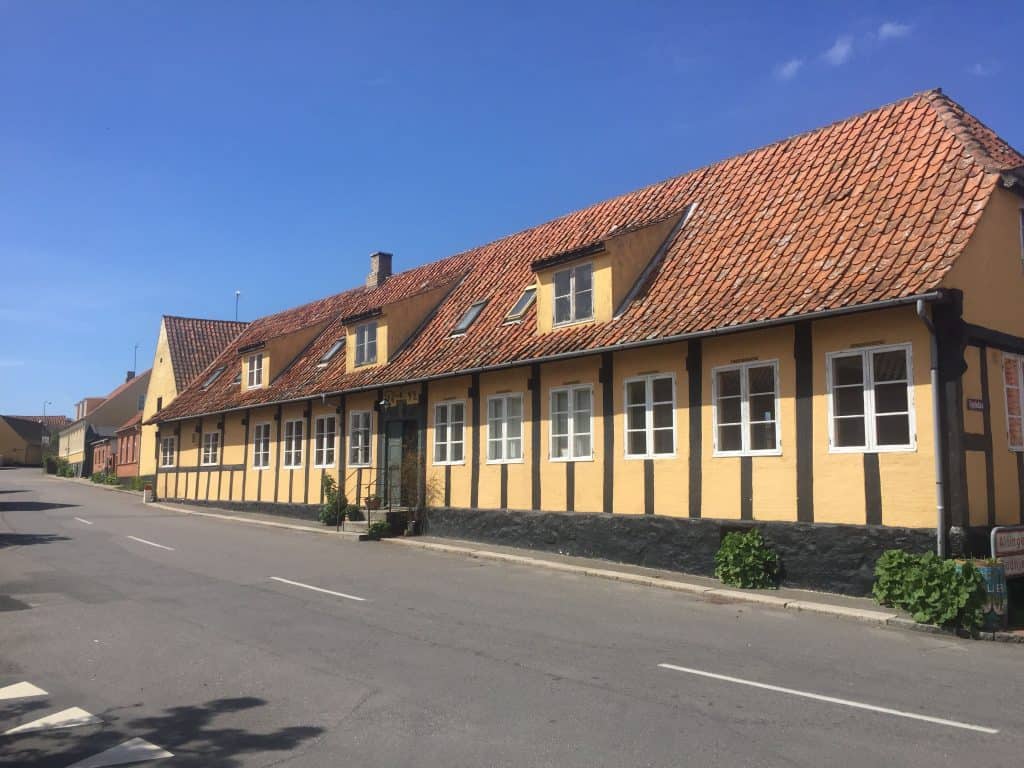
and cottages
We cycled out to visit the harbour villages we were not visiting by boat – Listed and Årsdale. In the latter we enjoyed ice creams in the harbour shop now run by the community. As well as buying provisions, you sit around a table chatting and drop some coins in the box for coffee consumed. We got into discussions over Brexit. It is amazing how fond of the UK the Danes are and how sad they are to see what is happening.
Passage to Rønne
On 14th May we had a nice NE wind F3-4 for our passage down the eastern side of Bornholm and westwards along the south coast.
While trying to set the spinnaker on a dead run we had a most unfortunate double wrap around the forestay. The top half of the spinnaker filled with wind on one side while the bottom half filled with wind on the other. The pressure tightened the middle wrapped around the forestay and made it impossible to unwrap it or snuff the sail. It took an hour of very strenuous work to finally get the sail down – to much relief.
After all that exertion, we decided to break our passage by anchoring off the south coast overnight. Despite open coast, the gentle off-shore wind made that a good prospect and we enjoyed the rest. However, in the morning we were unable to raise the anchor – it had jammed under a rock on the bottom. No amount of manoeuvring of the boat would free it. This was the first time in eight years we have been unable to retrieve it. Potentially, we were faced with having to abandon the anchor and seventy metres of chain. However, some years ago, we had purchased a device called an Anchor Rescue at the Southampton Boat Show. Such natty inventions often work better during a show demonstration that in the real world. But on this occasion after half an hour of trying, it freed the anchor!
Anchor fouling and rescue for those who want details
An anchor can become fouled – hooked under old chains or, in our case, jammed in a rock. In sever cases it would be necessary to commission a diver to go down to free it, which is very time consuming and expensive, especially if in a remote place.
The traditional precaution is to deploy the anchor with a trip-line attached to the crown of the anchor. The trip line has a small buoy floating on the surface. In the event the anchor is fouled, you retrieve the trip line and haul the anchor up by the crown.
In practice, trip-lines are often more trouble than they are worth. The small buoy may be run down by passing craft – we have lost two that way. If someone snags it, it can release the anchor in the middle of the night! It is also not uncommon for the trip-line to get caught in the prop while manoeuvring. In practice, trip-lines are only deployed if anchoring in a known fouled area.
The Anchor Rescue collar is fitted to the anchor and the anchor deployed as usual without a trip-line. In the event of a foul, a retriever is fitted around the chain and carries a trip-line down to the anchor where it engages with the collar and a lift force is transferred to the anchor crown. A video is available here.
Once free of the anchorage, we had a lovely sail to Rønne on the south western corner of Bornholm.
Rønne
Rønne is the main harbour and ferry port of Bornholm and its commercial centre. It was bombed heavily by the Soviets in May 1945 as the German commandant refused to surrender. It was then occupied by the Soviets for a year. There are still some lovely old houses, but it not much to attract the visitor compared with the other places we have visited.
We are sheltering here from two days of gales. We wonder whether the frequent gales we are seeing in May are a consequence of global warming. From here we will sail for Sweden before making our way to Copenhagen.
That’s the news for now. Ynskje & Tony
PS Our 2019 track can be seen here.

You must have been exhausted after the two incidents – spinnakers are a mixed blessing! However, what luck you had attached the collar to the anchor for the anchor rescue. I enjoyed looking at the video of how it works. Perseverance paid off for you and I hope you rested well after both difficulties. Liz
Hi both. Fascinating account of area and interesting pictures. Enjoy! Best Rick
Thank you again – such a great description of your journey! It is a pleasure to learn about so many different aspects of the places you visit. Esa´s ancestor (6 generations) Captain Aron Bergstrom´s ship wrecked at Bornholm coast in 1820. Family tradition has it that the islanders poisoned the Captain in order to get the cargo, and he was buried outside the church walls – but we don´t know which church! Take care!!